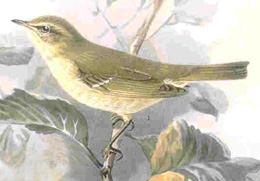|
| 질의: great white | 결과: 735번째/746 | |
Greenish Warbler (Phylloscopus trochiloides) - Wiki
| 제목: | Greenish Warbler (Phylloscopus trochiloides) - Wiki
| |

| 해상도: 260x181
파일크기: 24614 Bytes
등록시간: 2008:01:09 21:07:44
|
Greenish Warbler
From Wikipedia, the free encyclopedia
Order: Passeriformes
Family: Phylloscopidae
[Photo] Western Greenish Warbler (Phylloscopus trochiloides viridianus). Image from www.biologie.uni-hamburg.de/b-online/birds/2181_35.htm aus: NAUMANN, NATURGESCHICHTE DER V??GEL MITTELEUROPAS: Band II, Tafel 7 - Gera, 1897. URL: http://en.wikipedia.org/wiki/Image:Phylloscopus_trochiloides_NAUMANN.jpg
The Greenish Warbler, Phylloscopus trochiloides, is a widespread leaf-warbler throughout its breeding range in northeast Europe and northern Asia.
It breeds in lowland deciduous or mixed forest. The nest is on the ground in low shrub. Like its relatives, this small passerine is insectivorous.
This warbler is strongly migratory and winters in India.
This is a typical leaf-warbler in appearance, greyish-green above and off-white below. Its single wing bar distinguishes it from most similar species, except Arctic Warbler, Phylloscopus borealis. It is slightly smaller than that species and has a thinner bill, without a dark tip to the lower mandible. Its song is a high jerky trill.
This species occurs as a spring or early autumn vagrant in western Europe and is annual in Great Britain.
Systematics
Like all leaf-warblers, it was formerly placed in the "pan-Sylviidae" assemblage, but now belongs to the new leaf-warbler family Phylloscopidae (Alstr??m et al. 2006). It has a number of subspecies, of which P. t . viridianus is the most familiar in Europe (Snow et al. 1998). This is due to its evolution as a ring species, with populations evolving to the East and West of a plateau, later meeting on the other side, by which time there are two species. Their relationships are therefore fairly confusing (see Alstr??m 2006):
Eastern group: Greenish Warblers
- Phylloscopus trochiloides trochiloides: Greenish Warbler
Southern rim of the Himalaya eastwards from Nepal into W China.
Dusky greyish green above, often traces of second wing bar.
- Phylloscopus trochiloides obscuratus: Dull-green Warbler
Intermediate between trochiloides and plumbeitarsus.
Gansu and surroundings, China.
- Phylloscopus trochiloides plumbeitarsus: Two-barred Warbler
Breeds Eastern Siberian taiga.
Supercilium more yellow; upperparts more vivd green. 2 well-marked wing bars.
Western group: Green Warblers
- Phylloscopus trochiloides viridanus: Western Greenish Warbler
Breeds Western Siberia to north-east Europe; at east of range south to NW India.
Dull green above, with yellowish supercilium, throat, breast and faint wing bar.
- Phylloscopus trochiloides nitidus: Green Warbler or Bright-green Warbler
Caucasus region.
Brighter; underside much more yellow. One strong and one faint wing bar, especially in young birds.
Phylloscopus trochiloides plumbeitarsus is often split as distinct species, but phylogenetically, the western taxa are even more distinct.
Another approach to the systematics of this complex is to consider it a ring species. The groups' origin lies probably in the Himalayan region, where trochiloides is found. This taxon is close to the parapatric obscuratus and plumbeitarsus which is geographically separated from obscuratus.
On the other hand, there is some gene flow between trochiloides and the more distinct viridianus also, with their hybrids being especially common in Baltistan and once considered a subspecies ludlowi. On the other hand, viridianus whereas the latter and plumbeitarsus do not hybridize in the narrow zone in the western Sayan Mountains where their ranges overlap. nitidus is a mountain isolate that diverged from ancestral viridianus.
Song structure differs mainly between trochiloides and plumbeitarsus. The former has a fairly uniform, long, and warbling song. Around the Himalayas, song structure is similar, but songs are generally shorter. plumbeitarsus, on the other hand, has a long song that can be clearly divided into a warbling part, followed by series of up- and downslurred notes. The songs of obscuratus, and, interestingly, "ludlowi", are short, but contain the downslur elements too; in the latter, they uniquely appear at the start of the song.(Irwin 2000)
http://en.wikipedia.org/wiki/Greenish_Warbler
| The text in this page is based on the copyrighted Wikipedia article shown in above URL. It is used under the GNU Free Documentation License. You may redistribute it, verbatim or modified, providing that you comply with the terms of the GFDL. |
|
^o^
동물그림창고 똑똑전화 누리집
^o^
|
|